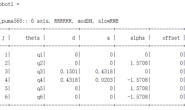连接ros
- 添加ROS插件
- 在ROS中控制Velodyne
在之前的文章中,我们构建的Velodyne传感器已经具有完整的功能,但这仅局限与仿真而已,与真实的机器人系统很难产生实际联系。因此,我们需要将gazebo与ros连接在一起,这样做的好处之一是,可以轻松地在真实世界和模拟世界之间进行切换,也就是说,你在仿真环境中实现的功能,在某些现实情况下,也能够轻易实现。为了做到这一点,我们需要让我们的传感器与ROS生态系统完美配合。
添加ROS插件
修改我们当前的插件内容,在其中添加ROS插件,其方式类似于在上一教程中添加Gazebo插件的方式。假设您的系统上当前已安装ROS。 1、在velodyne_plugin.cc文件中添加头文件。
#include <thread>
#include "ros/ros.h"
#include "ros/callback_queue.h"
#include "ros/subscribe_options.h"
#include "std_msgs/Float32.h"2、向插件添加一些成员变量。
/// \brief A node use for ROS transport
private: std::unique_ptr<ros::NodeHandle> rosNode;
/// \brief A ROS subscriber
private: ros::Subscriber rosSub;
/// \brief A ROS callbackqueue that helps process messages
private: ros::CallbackQueue rosQueue;
/// \brief A thread the keeps running the rosQueue
private: std::thread rosQueueThread; 3、在Load函数末尾,添加以下内容。
// Initialize ros, if it has not already bee initialized.
if (!ros::isInitialized())
{
int argc = 0;
char **argv = NULL;
ros::init(argc, argv, "gazebo_client",
ros::init_options::NoSigintHandler);
}
// Create our ROS node. This acts in a similar manner to
// the Gazebo node
this->rosNode.reset(new ros::NodeHandle("gazebo_client"));
// Create a named topic, and subscribe to it.
ros::SubscribeOptions so =
ros::SubscribeOptions::create<std_msgs::Float32>(
"/" + this->model->GetName() + "/vel_cmd",
1,
boost::bind(&VelodynePlugin::OnRosMsg, this, _1),
ros::VoidPtr(), &this->rosQueue);
this->rosSub = this->rosNode->subscribe(so);
// Spin up the queue helper thread.
this->rosQueueThread =
std::thread(std::bind(&VelodynePlugin::QueueThread, this)); 在以上代码中,定义了两个新函数:OnRosMsg和QueueThread,具体实现如下,将其添加到相应位置:
/// \brief Handle an incoming message from ROS
/// \param[in] _msg A float value that is used to set the velocity
/// of the Velodyne.
public: void OnRosMsg(const std_msgs::Float32ConstPtr &_msg)
{
this->SetVelocity(_msg->data);
}
/// \brief ROS helper function that processes messages
private: void QueueThread()
{
static const double timeout = 0.01;
while (this->rosNode->ok())
{
this->rosQueue.callAvailable(ros::WallDuration(timeout));
}
}4、最后需要修改的是cmake构建。
- 打开
CMakeLists.txt, 修改文件的顶部,如下所示。
cmake_minimum_required(VERSION 2.8 FATAL_ERROR)
find_package(roscpp REQUIRED)
find_package(std_msgs REQUIRED)
include_directories(${roscpp_INCLUDE_DIRS})
include_directories(${std_msgs_INCLUDE_DIRS})
- 修改插件的目标链接库
target_link_libraries(velodyne_plugin ${GAZEBO_LIBRARIES} ${roscpp_LIBRARIES})CMakeLists.txt应该是这样的。
cmake_minimum_required(VERSION 2.8 FATAL_ERROR)
find_package(roscpp REQUIRED)
find_package(std_msgs REQUIRED)
include_directories(${roscpp_INCLUDE_DIRS})
include_directories(${std_msgs_INCLUDE_DIRS})
# Find Gazebo
find_package(gazebo REQUIRED)
include_directories(${GAZEBO_INCLUDE_DIRS})
link_directories(${GAZEBO_LIBRARY_DIRS})
set(CMAKE_CXX_FLAGS "${CMAKE_CXX_FLAGS} ${GAZEBO_CXX_FLAGS}")
# Build our plugin
add_library(velodyne_plugin SHARED velodyne_plugin.cc)
target_link_libraries(velodyne_plugin ${GAZEBO_LIBRARIES} ${roscpp_LIBRARIES})
# Build the stand-alone test program
add_executable(vel vel.cc)
if (${gazebo_VERSION_MAJOR} LESS 6)
include(FindBoost)
find_package(Boost ${MIN_BOOST_VERSION} REQUIRED system filesystem regex)
target_link_libraries(vel ${GAZEBO_LIBRARIES} ${Boost_LIBRARIES})
else()
target_link_libraries(vel ${GAZEBO_LIBRARIES})
endif() 5、确保您已获取ROS源: source /opt/ros/<DISTRO>/setup.bash
cd ~/velodyne_plugin/build
cmake ../
make
在ROS中控制Velodyne
现在,我们可以照常加载Gazebo插件,它将在ROS主题上监听传入的浮动数据类型的消息(float)。然后,这些消息将用于设置Velodyne的转速。 1、启动roscore
source /opt/ros/<DISTRO>/setup.bash
roscore2、在新的终端中,启动gazebo
cd ~/velodyne_plugin/build
source /opt/ros/<DISTRO>/setup.bash
gazebo ../velodyne.world 3、在新的终端中,使用rostopic发送速度信息。
source /opt/ros/<DISTRO>/setup.bash
rostopic pub /my_velodyne/vel_cmd std_msgs/Float32 1.0更改以上命令的最后一个数字即可以设置不同的速度。




